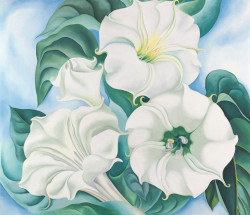
Georgia Totto O'Keeffe was an American artist. She was known for her paintings of enlarged flowers, New York skyscrapers, and New Mexico landscapes. O'Keeffe has been recognized as the "Mother of American modernism".

Alfred Stieglitz was an American photographer and modern art promoter who was instrumental over his 50-year career in making photography an accepted art form. In addition to his photography, Stieglitz was known for the New York art galleries that he ran in the early part of the 20th century, where he introduced many avant-garde European artists to the U.S. He was married to painter Georgia O'Keeffe.
Barbara Buhler Lynes is an art historian, curator, professor, and preeminent scholar on the art and life of Georgia O'Keeffe. She retired on February 14, 2020 from her position as the Sunny Kaufman Senior Curator at the NSU Museum of Art in Fort Lauderdale, Florida to continue her scholarly work on O'Keeffe and American modernism. From 1999-2012, she served as the founding curator of the Georgia O'Keeffe Museum in Santa Fe, New Mexico, where she curated or oversaw more than thirty exhibitions of works by O’Keeffe and her contemporaries. Lynes was also the Founding Emily Fisher Landau Director of the Georgia O'Keeffe Museum Research Center from 2001-2012. Prior to her work at the Georgia O'Keeffe Museum, Lynes served as an independent consultant to the National Gallery of Art in Washington, D.C. from 1992-1999 and has taught art history at Vanderbilt University, Dartmouth College, Montgomery College, and the Maryland Institute College of Art (MICA).

The Georgia O'Keeffe Museum is dedicated to the artistic legacy of Georgia O'Keeffe, her life, American modernism, and public engagement. It opened on July 17, 1997, eleven years after the artist's death. It comprises multiple sites in two locations: Santa Fe, New Mexico, and Abiquiu, New Mexico. In addition to the founding Georgia O'Keeffe Museum in Santa Fe, the O'Keeffe includes: the Library and Archive within its research center at the historic A.M. Bergere house; the Education Annex for youth and public programming; Georgia O'Keeffe's historic Abiquiu Home and Studio; the O'Keeffe Welcome Center in Abiquiu; and Museum Stores in both Santa Fe and Abiquiu. Georgia O'Keeffe's additional home at the Ghost Ranch property is also part of the O'Keeffe Museum's assets, but is not open to the public.

Cow's Skull: Red, White, and Blue is a painting by American artist Georgia O'Keeffe. The painting depicts a cow skull centered in front of what appears to be a cloth background. In the center of the background is a vertical black stripe. On either side of that are two vertical stripes of white laced with blue. At the outside of the painting are two vertical red stripes.

Maurice Wertheim was an American investment banker, chess player, chess patron, art collector, environmentalist, and philanthropist. Wertheim founded Wertheim & Co. in 1927.

Georgia O'Keeffe is a 2009 American television biographical film, produced by City Entertainment in association with Sony Television, about noted American painter Georgia O'Keeffe and her husband, photographer Alfred Stieglitz. The film was directed by Bob Balaban, executive-produced by Joshua D. Maurer, Alixandre Witlin and Joan Allen, and line-produced by Tony Mark. Shown on Lifetime Television, it starred Joan Allen and Jeremy Irons in lead roles.

Jimson Weed is an oil on linen painting by American artist Georgia O'Keeffe from 1936, located in the Indianapolis Museum of Art in Indianapolis, Indiana. It depicts four large blossoms of jimson weed. A similar work by O'Keeffe, Jimson Weed/White Flower No. 1, was sold by the Georgia O'Keeffe Museum at auction to Walmart heiress Alice Walton in 2014 for $44,405,000, more than tripling the previous world auction record for a piece by a female artist.

Katharine Nash Rhoades was an American painter, poet and illustrator born in New York City. She was also a feminist.
Doris Louise Huestis Speirs was a Canadian ornithologist, artist and poet. The "Doris Huestis Speirs Award" is an annual prize bestowed by the Society of Canadian Ornithologists to "an individual who has made outstanding lifetime contributions in Canadian ornithology". A member of the Art Students' League of Toronto and an art patron, she was the first Canadian to buy a Georgia O'Keeffe painting.

Marion Hasbrouck Beckett was an American painter.

Katherine Stieglitz, or Katherine Stieglitz Stearns, was the daughter of Emmeline, or Emmy, and Alfred Stieglitz, an American photographer and modern art promoter. She was the subject of many of her father's photographs, particularly in her early years. They were exhibited and received praise for their wholesome sentiment. She graduated from Smith College before marrying Milton Sprague Stearns. After the birth of her son in 1923, she was institutionalized for depression and hallucinations and remained there until her death in 1971.

Georgia O'Keeffe made a number of Red Canna paintings of the canna lily plant, first in watercolor, such as a red canna flower bouquet painted in 1915, but primarily abstract paintings of close-up images in oil. O'Keeffe said that she made the paintings to reflect the way she herself saw flowers, although others have called her depictions erotic, and compared them to female genitalia. O'Keeffe said they had misconstrued her intentions for doing her flower paintings: "Well – I made you take time to look at what I saw and when you took time to really notice my flower you hung all your own associations with flowers on my flower and you write about my flower as if I think and see what you think and see of the flower – and I don't."

O’Keeffe at the University of Virginia, 1912–1914 is an exhibition of watercolors that Georgia O'Keeffe created over three summers in the early 20th century at the University of Virginia. Shown at the Georgia O'Keeffe Museum in Santa Fe, New Mexico, the exhibit opened November 4, 2016 and ran through September 10, 2017. A year later, on October 19, 2018, the exhibition opened at the Fralin Museum of Art on the grounds of the University of Virginia, where it remained on display until January 27, 2019.
Light Coming on the Plains is the name of three watercolor paintings made by Georgia O'Keeffe in 1917. They were made when O'Keeffe was teaching at West Texas State Normal College in Canyon, Texas. They reflect the evolution of her work towards pure abstraction, and an early American modernist landscape. It was unique for its time. Compared to Sunrise that she painted one year earlier, it was simpler and more abstract.
The early works of American artist Georgia O'Keeffe are those made before she was introduced to the principles of Arthur Wesley Dow in 1912.

Black Iris, sometimes called Black Iris III, is a 1926 oil painting by Georgia O'Keeffe. Art historian Linda Nochlin interpreted Black Iris as a morphological metaphor for female genitalia. O'Keeffe rejected such interpretations in a 1939 text accompanying an exhibition of her work by writing: "Well—I made you take time to look at what I saw and when you took time to really notice my flower you hung all your own associations with flowers on my flower and you write about my flower as if I think and see what you think and see of the flower—and I don't." She attempted to do away with sexualized readings of her work by adding a lot of detail.

Georgia O'Keeffe made a set of paintings of Palo Duro Canyon while working as a department head and art instructor at West Texas State Normal College. The vibrant paintings reflect her development as an Abstract Expressionist, influenced by Arthur Wesley Dow.

The American artist Georgia O'Keeffe is best known for her close-up, or large-scale flower paintings, which she painted from the mid-1920s through the 1950s. She made about 200 paintings of flowers of the more than 2,000 paintings that she made over her career. One of her paintings, Jimson Weed, sold for $44.4 million, making it the most expensive painting sold of a female artist's work as of 2014.
Maria Chabot (1913–2001), was an advocate for Native American arts, a rancher, and a friend of Georgia O'Keeffe. She was the general contractor for her house in Abiquiú, New Mexico and took the photograph of O'Keeffe entitled Women Who Rode Away, in which the artist was on the back of a motorcycle driven by Maurice Grosser. Their correspondence was published in the book Maria Chabot—Georgia O'Keeffe: Correspondence 1941-1949.



















